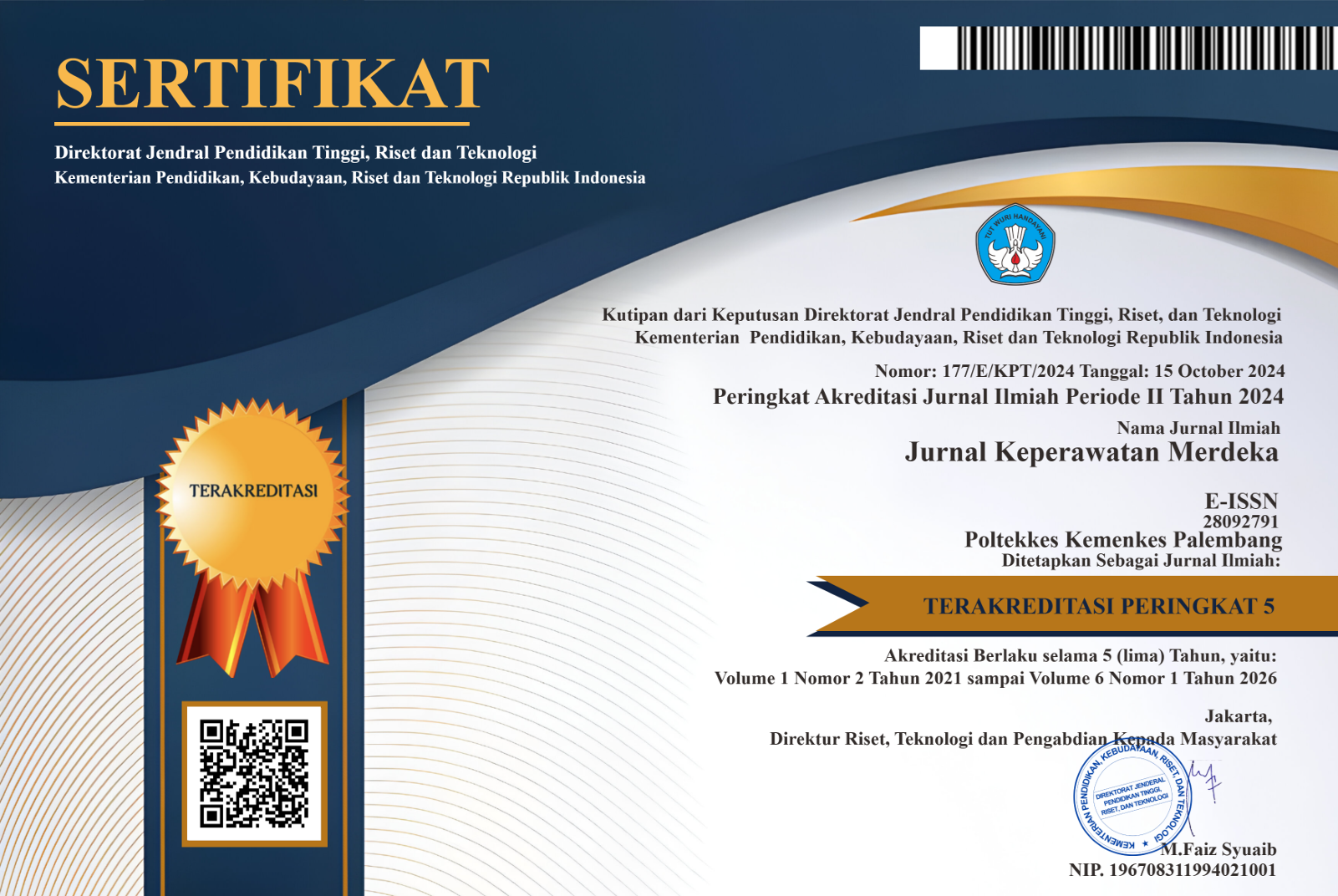Implementasi Asuhan Keperawatan Keluarga Penderita Stroke Dengan Masalah Kekuatan Otot Melalui Latihan Range of Motion
Abstract
Latar Belakang: Dampak yang paling banyak dialami penderita pasca stroke adalah kelemahan otot ekstremitas yang dapat menghambat aktivitas sehari-hari. Tujuan: Peneliitian ini bertujuan untuk mengimplementasikan latihan range of motion pada penderita pasca stroke. Desain penelitian ini adalah deskriptif kualitatif dengan pendekatan asuhan keperawatan keluarga. Asuhan keperawatan diberikan pada dua keluarga dengan anggota keluarga mengalami stroke dalam 6 bulan terakhir dan mengalami kelemahan otot lengan dan tungkai. Pengukuran kekuatan otot menggunakan Manual Muscle Test. Hasil: Diagnosa keperawatan keluarga yang dapat diidentifikasi adalah hambatan mobilitas fisik penderita pasca stroke berhubungan dengan kelemahan otot, kurangnya pengetahuan keluarga berhubungan dengan ketidakmampuann mengenal masalah dan risiko jatuh berhubungan dengan kurangnya kemampuan keluarga dalam memodifikasi lingkungan rumah sehat. Hasil evaluasi menunjukkan adanya peningkatan kekuatan otot sebesar satu skala Manual Muscle Test. Kesimpulan: Manajemen penatalaksanaan dini dengan metode yang tepat pada penderita pasca stroke dengan kelemahan otot sangat diperlukan. Pentingnya peran keluarga dalam memberikan latihan range of motion untuk mencegah kecacatan permanen akibat kelemahan otot pasca stroke.
References
Anggraini, Zulkarnain, Sulaimani, & Gunawan, R. (2018). Effect of Rom (Range of Motion) on The Strength of Muscle Extremity in Non-Hemoragic Stroke Patients. Jurnal Riset Hesti Medan, 3(2), 64–72.
Badan Penelitian dan Pengembangan Kesehatan. (2013). Riset Kesehatan Dasar (RISKESDAS) 2013. Laporan Nasional 2013, 1–384. https://doi.org/1 Desember 2013
Badan Penelitian dan Pengembangan Kesehatan. (2019). Riset Kesehatan Dasar 2018. Retrieved from https://www.litbang.kemkes.go.id/laporan-riset-kesehatan-dasar-riskesdas/
Batchelor, F., Hill, K., MacKintosh, S., & Said, C. (2010). What works in falls prevention after stroke?: A systematic review and meta-analysis. Stroke, 41(8), 1715–1722. https://doi.org/10.1161/STROKEAHA.109.570390
Bohannon, R. W. (2007). Muscle strength and muscle training after stroke. Journal of Rehabilitation Medicine, 39(1), 14–20. https://doi.org/10.2340/16501977-0018
Chung, S. H., Kim, J. H., Yong, S. Y., Lee, Y. H., Park, J. M., Kim, S. H., & Lee, H. C. (2019). Effect of task-specific lower extremity training on cognitive and gait function in stroke patients: A prospective randomized controlled trial. Annals of Rehabilitation Medicine, 43(1), 1–10. https://doi.org/10.5535/arm.2019.43.1.1
Esti, A., & Johan, T. R. (2020). Keperawatan Keluarga; Askep Stroke. Padang, Indonesia: Pustaka Galeri Mandiri.
Hosseini, Z.-S., Peyrovi, H., & Gohari, M. (2019). The Effect of Early Passive Range of Motion Exercise on Motor Function of People with Stroke: a Randomized Controlled Trial. Journal of Caring Sciences, 8(1), 39–44. https://doi.org/10.15171/jcs.2019.006
Johnson, C. O., Nguyen, M., Roth, G. A., Nichols, E., Alam, T., Abate, D., … Murray, C. J. L. (2019). Global, regional, and national burden of stroke, 1990–2016: a systematic analysis for the Global Burden of Disease Study 2016. The Lancet Neurology, 18(5), 439–458. https://doi.org/10.1016/S1474-4422(19)30034-1
Junaidi, I. (2004). Panduan Praktis Pencegahan dan Pengobatan Stroke (2nd ed.). Jakarta Indonesia: PT. Bhuana Ilmu Populer.
Kim, H., Cho, S., & Lee, H. (2019). Effects of passive Bi-axial ankle stretching while walking on uneven terrains in older adults with chronic stroke. Journal of Biomechanics, 89, 57–64. https://doi.org/10.1016/j.jbiomech.2019.04.014
Marlina, Badaruddin, Fikarwin, Z., & Lubis, R. (2020). Model of family health empowerment preventing stroke in Puskesmas Ulee Kareng Banda Aceh. Journal of Physics: Conference Series, 1460(1), 1–6. https://doi.org/10.1088/1742-6596/1460/1/012076
Nawata, K., Sugano, H., & Kimura, M. (2019). An Analysis of the Effects of Blood Pressure and Antihypertensive Drugs on Heart Disease. Health, 11(06), 792–816. https://doi.org/10.4236/health.2019.116064
Nur Rahayu, K. I. (2015). Pengaruh pemberian latihan. Jurnal Keperawatan PENGARUH PEMBERIAN LATIHAN RANGE OF MOTION (ROM) TERHADAP KEMAMPUAN MOTORIK PADA PASIEN POST STROKE DI RSUD GAMBIRAN, 6(2010), 102–107. Retrieved from https://media.neliti.com/media/publications/138683-ID-pengaruh-pemberian-latihan-range-of-moti.pdf
Schwarz, A., Bhagubai, M. M. C., Wolterink, G., Held, J. P. O., Luft, A. R., & Veltink, P. H. (2020). Assessment of upper limb movement impairments after stroke using wearable inertial sensing. Sensors (Switzerland), 20(17), 1–22. https://doi.org/10.3390/s20174770
Winstein, C. J., Stein, J., Arena, R., Bates, B., Cherney, L. R., Cramer, S. C., … Zorowitz, R. D. (2016). Guidelines for Adult Stroke Rehabilitation and Recovery: A Guideline for Healthcare Professionals from the American Heart Association/American Stroke Association. In Stroke (Vol. 47). https://doi.org/10.1161/STR.0000000000000098
World Health Organization. (2020). Active Ageing: Moving Hearts For Health. Retrieved from https://www.who.int/news/item/27-09-2002-active-ageing-moving-hearts-for-health
Yuniati, F., & Kamso, S. (2021). Assessing the Quality of Life Among Productive Age in the General Population: A Cross-Sectional Study of Family Life Survey in Indonesia. Asia-Pacific Journal of Public Health, 33(1), 53–59. https://doi.org/10.1177/1010539520956411
Yuniati Faiza, D. Y. (2014). Pemanfaatan Posyandu Lanjut Usia. Jurnal Kesehatan Politeknik Kesehatan Palembang, 1, 30–33. Retrieved from https://jurnal.poltekkespalembang.ac.id/index.php/JPP/article/download/170/133
Copyright (c) 2021 JKM : Jurnal Keperawatan Merdeka

This work is licensed under a Creative Commons Attribution-ShareAlike 4.0 International License.
Authors who publish with this journal agree to the following terms:
- Authors retain copyright and grant the journal right of first publication with the work simultaneously licensed under a Creative Commons Attribution License that allows others to share the work with an acknowledgement of the work's authorship and initial publication in this journal.
- Authors are able to enter into separate, additional contractual arrangements for the non-exclusive distribution of the journal's published version of the work (e.g., post it to an institutional repository or publish it in a book), with an acknowledgement of its initial publication in this journal.
- Authors are permitted and encouraged to post their work online (e.g., in institutional repositories or on their website) prior to and during the submission process, as it can lead to productive exchanges, as well as earlier and greater citation of published work













